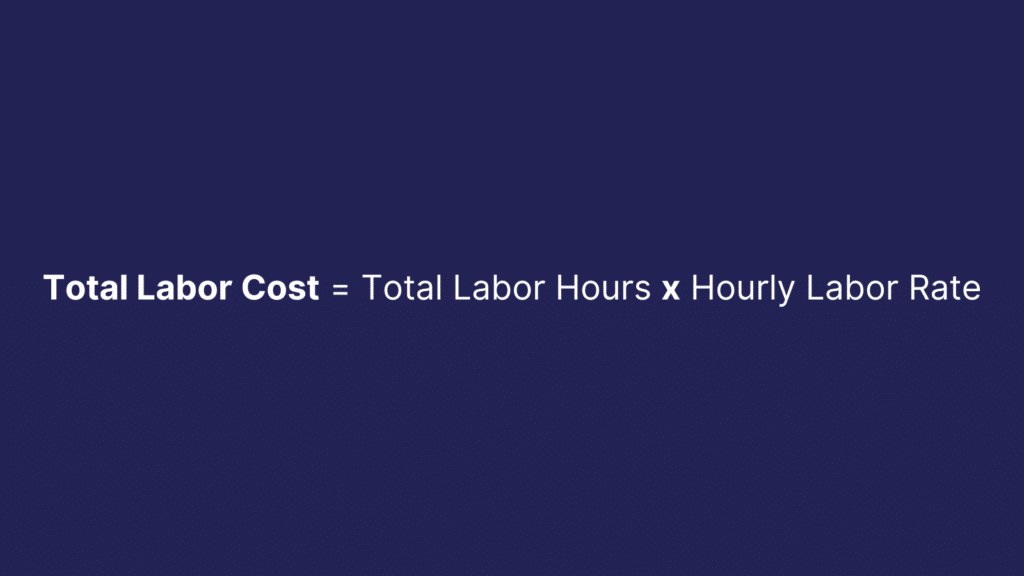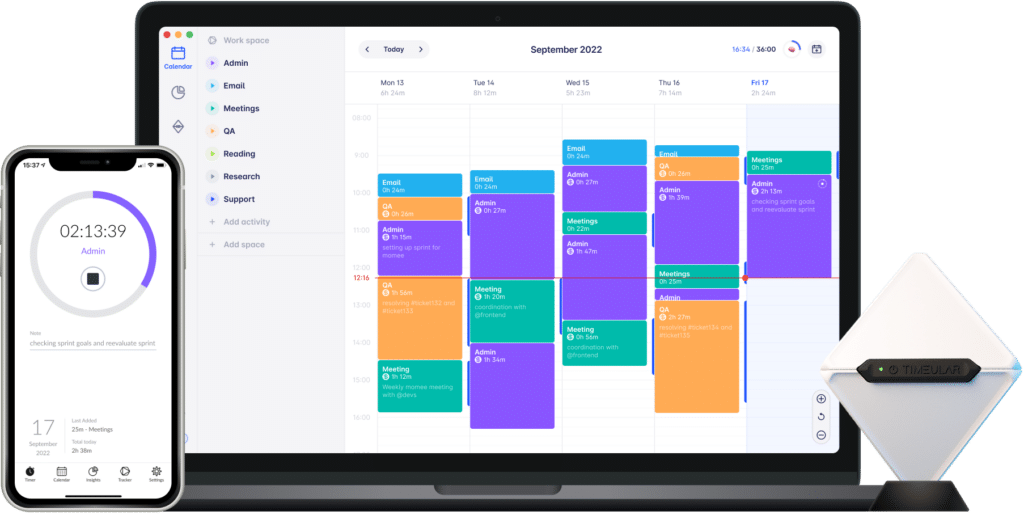Wie man Arbeitskosten berechnet
Labor costs, including employee costs, operating costs, minimum wage, payroll taxes, and overhead costs, often form a significant part of a company’s annual expenses. Balancing fair compensation with business profitability is essential.
Calculating labor costs offers a realistic view of each employee’s financial impact, aiding informed decision-making and the development of strategies to control or reduce expenses.
In this article, we’ll explore the labor cost definition, how to calculate labor cost, and how to reduce labor costs.
Start tracking employee time with Timeular!
What is labor cost?
Labor cost is the amount of money a business spends on its workforce. This includes not only the salaries (direct labor costs) but also related expenses. Usually, an average labor cost includes fixed costs and additional costs beyond employee costs such as:
- Payroll taxes
- Medicare taxes
- Krankenkasse
- Employer retirement contributions
- Social security
- Life insurance
- Überstunden
- Paid time off
- Bonuses
- Training costs
- Food costs
- Equipment and supplies (protective gear, uniform, cell phone, desks, chairs…)

What are the different types of labor costs?
- Direct labor costs: These are expenses directly tied to the production of goods or services, such as wages paid to workers directly involved in manufacturing or delivering a product.
- Indirect labor costs: Indirect labor costs includes wages for employees not directly involved in production, like supervisors, maintenance staff, or quality control personnel.
- Overtime costs: This includes any additional wages paid to employees for working beyond their regular hours, often at a higher rate than standard pay.
- Employee benefits: These encompass other expenses beyond wages, such as healthcare, retirement contributions, paid time off, and other perks provided to employees.
- Training costs: Expenses related to training employees, including materials, instructors, and resources used for skill development or onboarding.
- Labor burden costs: Additional indirect costs associated with employing labor, like payroll taxes, insurance, worker’s compensation, and other overhead expenses.
- Contractor costs: Payments made to external contractors or freelancers for specific services rendered, which might involve a fixed fee or hourly rate.

Labor cost calculation with a simple labor cost formula
The labor cost formula is: Total Labor Cost = Total Labor Hours x Hourly Labor Rate
This formula calculates the overall labor cost by multiplying the total number of labor hours expended on a project by the hourly rate paid to each worker involved.
Direct and indirect labor cost: What’s the difference?
While direct labor cost relate solely to the salaries employees get paid, indirect labor cost are all the other benefits we mentioned above.
Even if some of them are not visible to the employees, they are still costs that the company has to consider when calculating an employee’s labor cost.

Why is labor cost calculation so important?
Labor cost analysis shows its significance in several areas of a business. Let’s analyze some of them to better understand why calculating labor cost is so important for any company.
Cost control and budgeting
Labor cost often constitutes a big portion of a company’s total operating costs. Analyzing the actual annual labor cost helps businesses understand and control how they spend their money, allowing for successful budgeting and financial planning.
Product pricing
Labor cost analysis plays a crucial role in determining the pricing of goods or services. By accurately calculating labor costs your businesses can set competitive prices, ensuring profitability.
Performance measurement
Comparing labor costs against key performance indicators helps in assessing your workforce’s productivity and efficiency. It enables businesses to identify high-performing employees or teams and address areas that need improvement.
Read also: Managing high-performing employees
Strategic decision-making
Labor cost analysis informs strategic decision-making regarding workforce management, staffing levels, and organizational structure.
It also helps businesses align their human resources with the overall business objectives and adapt to changing market conditions.
Resource allocation
Companies can optimize their resource allocation by identifying areas where fixed labor cost can be better managed. This may involve restructuring teams, implementing training programs, or adjusting compensation structures.
Lies auch:

How to calculate labor cost: Example
Three main methods can be used to calculate labor cost, depending on the analysis you wish to make and the field your business is in. They are the Hourly Rate Calculation, Labor Cost per Unit Calculation, and the Labor Cost Percentage Calculation
Below, we’ll explore each of them, explaining how they can be used and their business advantages.
Hourly Rate Calculation – direct labor cost formula:
This method allows you to calculate direct labor cost per hour of each employee. Consider the salaries and hours worked per month using this formula:
Hourly Rate = Salary / Hours Worked per Month
Beispiel:
If an employee has a base salary of 1500 dollars/euros after taxes and works 168 hours per month, their hourly rate would be:
Hourly Rate = 1500$ : 168 = $8,92
As we mentioned, to calculate total labor costs, you should also consider any indirect labor costs like potential benefits and taxes. Let’s consider $1000 in monthly benefits and taxes, and divide it by the number of worked hours.
$1000 : 160 = $6,25
If we add the two values, we’ll have the final hourly labor cost of an employee:
$8,92 + $6,25 = $15,17
This method is beneficial if you use time tracking or if you want to calculate the actual labor costs of each employee individually. However, if you want to understand the overall weight each employee labor cost has in your budget, you might benefit from using a percentage calculation.
DOWNLOAD:
Kostenlose Vorlagen für abrechenbare Stunden
Zeitmanagement Zeitplan Vorlage

Labor Cost Percentage Formula
The Labor Cost Percentages method is used to calculate the proportion of a company’s total expenses that is allocated to labor cost. It is calculated by dividing the total labor cost by the total expenses and expressing the result as a percentage.
First, you need to add all the variable costs, relating to fixed labor costs during a certain time: salaries, benefits, and payroll taxes paid, among other factors. Then, you’ll identify the total expenses generated by the business during the same period for which you calculate the labor cost.
Once you have all the data, you’ll need to use the following formula to calculate labor cost percentage:
Labor Cost Percentage = (Total Expenses/Total Labor Costs) ×100
Example
Imagine your company’s total labor cost for a period were $100,000, and your total expenses for the same period were $500,000. Using the formula, you’ll get:
Labor Cost Percentage = (100,000 /500,000) × 100 = 20%
This means that 20% of your total expenses are entirely allocated to labor cost.
Even though this formula allows you to get a good overview of the overall labor cost your company might have, it still is a very broad metric, as it doesn’t give you a detailed value for each employee or department.
A good labor cost percentage typically falls within the range of 20-30% of total revenue, though this can vary based on industry and specific business factors.
Labor Cost per Unit Calculation
The Labor Cost per Unit is a method mostly used in the manufacturing and service-based industries, as it allows you to determine the average cost of labor required to produce a single unit of a product or service.
To calculate this metric, you’ll need to determine the hourly rate for your employees (which we’ve previously explained) and multiply it by the number of hours you need to produce a unit or complete a service, like this formula:
Labor Cost per Unit = Hourly Rate x Number of Hours to Produce Unit or Complete Service
Imagine an employee hourly rate of $15/hour, including all direct labor and indirect labor costs, and a service that takes 3 hours to be completed.
The formula would assume these numbers and give you the following result:
Labor Cost per Unit = $15 x 3 = $45
In this case, your Labor Cost per Service would be $45, which means it costs your company $45 to complete a specific service.

Factors that influence labor cost
Employee wages and salaries
The most direct and significant factor is the actual compensation paid to employees. Different roles, skill levels, and geographic locations can result in varying wage rates, which results in different labor costs.
For example, if your company’s roles require people with more knowledge and technical skills, you’ll probably have higher labor costs.
Overtime and shift differentials
Overtime and shifts can directly impact your labor costs. Overtime hours usually have their hourly rate, which is usually higher.
Likewise, in the case of shifts, your employees’ hourly rates may vary according to the type of shifts they work.
TIP: To calculate overtime hours, use our free Overtime Calculator. In case you need to track overtime regularly, switch to the Overtime Tracker.
Employee benefits and taxes
As we mentioned previously, employee benefits, including health insurance, retirement plans, paid time off, and other perks, contribute to the overall labor cost of a company.
The types and extent of benefits provided by the employer can impact costs in a significant way.
Training and development expenses
If your company offers training and development opportunities to its employees, it can also impact labor costs. Depending on the level of specialization your employees have, the labor cost percentage can be lower or higher.
Das könnte dich auch interessieren:
- Wie man Zeitmanagement lehrt
- Top time management training courses
- Top project management courses
- Good courses to improve communication skills

Why is time tracking important for calculating and managing labor costs?
- Accurate payroll: employee time tracking data helps in accurately calculating their compensation. Whether it’s hourly wages or overtime pay, having precise records of time worked ensures fair and correct payroll processing.
- Cost allocation: the data provided by time tracking allows businesses to allocate labor costs to specific projects, tasks, or clients accurately. This helps in understanding the true cost of each project and ensures correct client billing.
- Productivity analysis: monitoring time spent on different tasks or projects provides insights into employee productivity. It helps identify inefficiencies, bottlenecks, or areas where additional training or resources might be needed.
- Resource management: Knowing how much time is spent enables better resource management. It helps in assigning tasks effectively, balancing workloads, and optimizing productivity by allocating resources where they are most needed.
- Cost control and budgeting: A time tracking app assists in controlling costs by revealing where resources are being utilized most and where they might be wasted. This information is vital for budgeting accurately and making informed decisions to manage labor expenses effectively.
Overall, time tracking is integral to understanding, managing, and controlling labor costs. It provides valuable data that aids in various aspects of business operations, from payroll accuracy to resource optimization and compliance with regulations.
Start tracking employee time with Timeular!
Schlussfolgerung
Labor costs are a necessary expense to keep companies running, and employees should be fairly compensated for their work. However, even a necessary expense can be controlled using the right methods.
Calculate your labor costs and analyze if they need to be lowered. If so, follow our strategies to achieve manageable, lower labor costs and maintain your business health in good shape.
Compensate your employees while keeping your financial goals!
FAQ
What is the significance of labor cost analysis?
Labor cost analysis can be used to control operating costs and budgets, determine product pricing, measure performance, efficient resource allocation, negotiations with employees, and strategic decision-making.
How can I control labor costs in my business?
To control rising labor costs, in your business, you can use many strategies, such as workforce and overtime management, using technology to aid in day-to-day tasks, and implementing programs to improve the quality of your employees.
- TIP: Start using a workforce management system to improve your business efficiency.
What is the formula for the labor budget?
To calculate a labor budget, you need to estimate the number of hours needed to finish the project and multiply that number by your hourly rate.
Are taxes and benefits included in labor cost calculations?
Yes, taxes and benefits are often included in labor cost calculations. When determining the total cost of labor, it is essential to account for various other expenses beyond just gross wages, or hourly rates.
How to calculate labor costs for a project?
To calculate labor costs for a project, estimate the total hours needed for completion across all tasks, multiply by the hourly rate for each worker involved, and include additional expenses such as benefits or overheads, providing a comprehensive labor cost for the entire project.
Empfohlene Werkzeuge:
How do you calculate the actual unit cost?
To calculate a unit cost, you need to use the Labor Cost per Unit formula, which is:
Labor Cost per Unit = Hourly Rate x Number of Hours to Produce Unit or Complete Service
How to calculate standard labor costs?
To calculate standard labor cost, you can use 3 methods, depending on the type of calculation you need: Hourly Rate Calculation, Labor Cost per Unit Calculation, and Labor Cost Percentage Calculation.